|
Chandler, Alfred, 1804-1896.
Illustrations and descriptions of the plants which compose the natural order Camellieae and of the varieties of Camellia japonica, cultivated in the gardens of Great Britain / the drawings by Alfred Chandler ; the descriptions by William Beattie Booth. [Vol. 1]
London : J. and A. Arch, 1831.
xii, 48 p., 40 leaves of plates : col. ill. ; 39 cm.
No more published.
Plate 4 "Camellia reticulata"
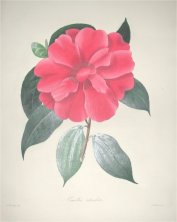 William Beattie Booth was recognized as a leading expert on Camellias, presenting a paper on the subject in two sessions of the Horticultural Society in London in 1829. Although fellowship in the Society largely consisted of the landed gentry, esteemed gardeners on the estate were often granted the status of corresponding members. Booth is listed in the published papers as "Garden Clerk." Alfred Chandler was a well-known nurseryman in Vauxhall.
William Beattie Booth was recognized as a leading expert on Camellias, presenting a paper on the subject in two sessions of the Horticultural Society in London in 1829. Although fellowship in the Society largely consisted of the landed gentry, esteemed gardeners on the estate were often granted the status of corresponding members. Booth is listed in the published papers as "Garden Clerk." Alfred Chandler was a well-known nurseryman in Vauxhall.
Hand-colored lithographs. Note the glossy effect on the leaves from a material overlaying the watercoloring.
Elwes, Henry John, 1846-1922.
A monograph of the genus Lilium / by Henry John Elwes. Illustrated by W.H. Fitch.
[London] : Printed by Taylor and Francis, 1877-80.
7 pts. in 1 v. (xv, [83] p.), 48 leaves of plates : col. ill. ; 57 cm.
Plate 20/1 "Lilium elegans, var. incomparabile"
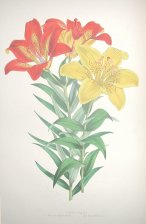 Walter Hood Fitch was the most prolific and outstanding botanical artist of the 19th century, publishing nearly a thousand images. When William Hooker was appointed director of the Royal Gardens at Kew in 1841, he brought Fitch with him from Glasgow, where he had employed him in his work as chair of botany. Fitch started publishing in the Botanical magazine in 1834, became its sole artist soon after, and remained so until 1877. In the Kew bulletin of 1915, W. B. Hemsley describes Fitch at work on the Lilium, "without hesitation, and with a rapidity and dexterity that was simply marevellous."
Walter Hood Fitch was the most prolific and outstanding botanical artist of the 19th century, publishing nearly a thousand images. When William Hooker was appointed director of the Royal Gardens at Kew in 1841, he brought Fitch with him from Glasgow, where he had employed him in his work as chair of botany. Fitch started publishing in the Botanical magazine in 1834, became its sole artist soon after, and remained so until 1877. In the Kew bulletin of 1915, W. B. Hemsley describes Fitch at work on the Lilium, "without hesitation, and with a rapidity and dexterity that was simply marevellous."
Hand-colored lithographs.
Hand-colored Lithograph - Planographic
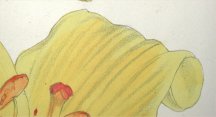 Lithography was invented by Alois Senefelder in Germany in 1798. An illustration or text is drawn with a grease pen or chalk on the surface of a specially prepared stone. The stone is then dampened and ink applied. The water repels the ink while adhering to the greasy areas. The print is made on a press somewhat similar to the presses for intaglio printing. Lithographs can be done in a variety of ways, but this example was done in the chalk style. The surface of the stone was roughened and a type of chalk or crayon and a pen was used. The bits of chalk stuck to the hilltops of the stone, not the valleys, and produce an irregular dotted pattern when printed. The degree of darkness is controlled by how hard the chalk is applied to the stone. Any method of printing from a flat surface is termed planographic. This example was hand-colored after printing.
Lithography was invented by Alois Senefelder in Germany in 1798. An illustration or text is drawn with a grease pen or chalk on the surface of a specially prepared stone. The stone is then dampened and ink applied. The water repels the ink while adhering to the greasy areas. The print is made on a press somewhat similar to the presses for intaglio printing. Lithographs can be done in a variety of ways, but this example was done in the chalk style. The surface of the stone was roughened and a type of chalk or crayon and a pen was used. The bits of chalk stuck to the hilltops of the stone, not the valleys, and produce an irregular dotted pattern when printed. The degree of darkness is controlled by how hard the chalk is applied to the stone. Any method of printing from a flat surface is termed planographic. This example was hand-colored after printing.
Sander, F. (Frederick), 1847-1920.
Reichenbachia : Orchids illustrated and described / by F. Sander, with the assistance of scientific authority ...
London : H. Sotheran & Co. ... ; St. Albans [Eng.] : F. Sander & Co. Orchid growers & importers ; New York : I. Forstermann ... , 1888-1894.
2 v., 96 leaves of plates: col. ill. ; 69 cm.
A 2d series was issued, 1892-94.
Volume 1, plate 21 "1. Oncidium Jonesianum 2. Oncidium Jonesianum phaeanthum"
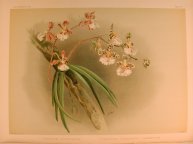 The series was named after Heinrich Gustav Reichenbach, an eminent botanist and specialist in orchids. Sanders was the founder of a large nursery firm and determined to publish a book on orchids from all over the world. He employed about 20 collectors to gather specimens. For the illustrations, he chose Henry Moon, who firmly believed that flowers should be portrayed as they are and not altered to an ideal image.
The series was named after Heinrich Gustav Reichenbach, an eminent botanist and specialist in orchids. Sanders was the founder of a large nursery firm and determined to publish a book on orchids from all over the world. He employed about 20 collectors to gather specimens. For the illustrations, he chose Henry Moon, who firmly believed that flowers should be portrayed as they are and not altered to an ideal image.
Chromolithograph.
Chromolithograph - Planographic
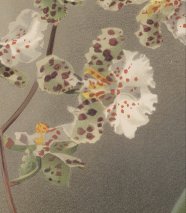 In chromolithography, a number of stones would be prepared, each bearing a different color ink. The print would be carefully placed in the same position, or registered, on the stone so the ink would go where intended.
In chromolithography, a number of stones would be prepared, each bearing a different color ink. The print would be carefully placed in the same position, or registered, on the stone so the ink would go where intended.
|
![]()

![]()

![]()